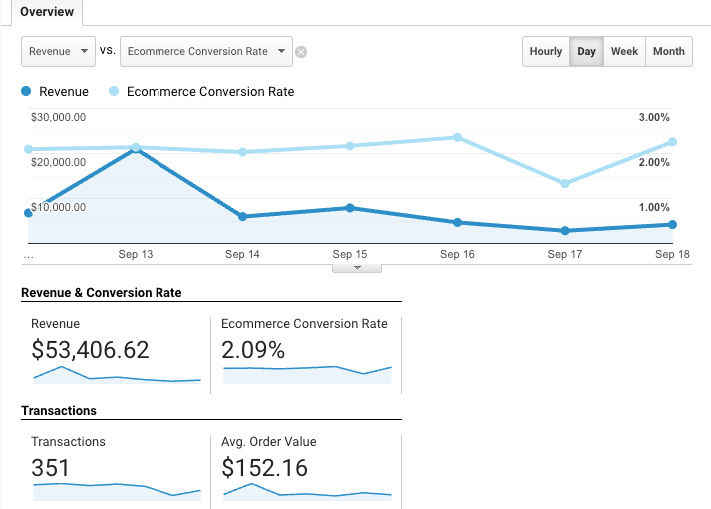-
 Published: Oct 28, 2022
Published: Oct 28, 2022
-
 6 min. read
6 min. read
-
 Macy Storm
Macy Storm Senior Content Creator
Senior Content Creator
- Macy is a marketing writer with over five years of experience creating content for dozens of industries including food and beverage, home services, and education. She also specializes in creating SEO and PPC content. Her work has been featured by Search Engine Journal, HubSpot, Entrepreneur, Clutch, and more. In her free time, Macy enjoys trying new crafts and reading comic books.
Revenue is critical for helping you make the right decisions now, so you can grow your business later. With revenue forecasting, you can predict future revenue to help set your business up for success.
Keep reading to learn more about forecasting revenue, including:
- What is revenue forecasting?
- 4 types of revenue forecast models you can use
- 3 tips for doing revenue forecasting
And if you want to get more tips and tricks for increasing your business’s revenue, join 200,000 marketers by subscribing to Revenue Weekly!
What is revenue forecasting?
Revenue forecasting is the process of estimating future revenue for your company. When you create a revenue forecast, you predict how much revenue your company will make over a specific period, so you can make data-backed decisions that help you earn that revenue and more. It’s similar in many ways to sales forecasting.

4 revenue forecasting models you can use
If you want to do revenue forecasting, start by using a revenue projection model. This model will help you predict future revenue fast and efficiently.
There are numerous revenue forecast models you can use, including:
- Backlog revenue forecast model
- Pipeline revenue forecast model
- Historical performance revenue forecast model
- Bottom-up revenue forecasting model
Let’s look at these models more in-depth:
1. Backlog revenue forecast model
First on our list of revenue projection models is the backlog model. With this model, you look at the amount of revenue your business is projected to earn based on current contracts. You haven’t earned this money yet, but you will earn it when those contracts start or renew.
This approach enables you to look realistically at how much revenue you’ll drive for your business. If you already have clients that you know will renew their services, you can anticipate that revenue and include it as part of your forecast.
The backlog model is the best option for your business if you’re looking for steady growth over time and want to analyze your growth rate. The backlog can help you understand how much money you’ll be earning, so you can adjust to earn more.
2. Pipeline revenue forecast model
Another revenue forecasting model you can use is the pipeline model. This model requires you to predict revenue based on your organization’s current sales pipeline. You make an educated guess on how many leads in your sales pipeline will become sales and the worth of that sale.
This approach differs from the backlog model because it requires you to guess and predict who may become a sale for your business. There are no guaranteed contracts, but rather, educated guesses built from your sales data.
The pipeline revenue forecast model is a great option if you’re just starting with forecasting revenue and want to look at data that’s easy to understand. Just keep in mind that you need to keep your predictions realistic, so it doesn’t lead to over-projection and coming up short.
3. Historical performance revenue forecast model
If you’re looking for a revenue forecast model that you can do fast, historical performance is the solution for you. With a historical performance model, you use past performance data to serve as a baseline for the revenue you earn in the future.
For example, if you have 20 clients and earned $2 million in one year, that would be your baseline to predict your revenue for the next year. You then look at current market conditions to determine future impacts on your revenue. You’ll want to consider factors like:
- Adding a new product or service (which attracts new clients)
- Losing a major client
- Gaining a major client
- Current market conditions
- And more
This model helps you create a baseline and use the current market to predict revenue for your business.
Bonus Read: What is Revenue Run Rate?
4. Bottom-up revenue forecasting model
The last model we’ll discuss regarding revenue forecasting is the bottom-up model. With this model, you look at all your planned work, which includes proposals and current projects, and use that information to create a revenue forecast.
This model enables you to see the revenue you drive by completing projects within an estimated time frame. The bottom-up model gives you a clearer picture of your operations, so you can determine factors like how much you need to invest in resources, how quickly you complete projects (so you can take on additional projects and earn more revenue), and more.
Use the bottom-up revenue projection model if you want a more accurate representation of your predicted revenue.
3 tips for doing revenue projection right
Now that you’ve looked at the revenue forecast models, you can start implementing one for your business. Here are some tips to help you see success with your revenue forecast!
1. Choose the right model
If you want to have the best idea of your predicted revenue, start by choosing the right revenue forecasting model. You want to ensure you’re choosing the model that fits best with your business structure and the data you have to make your predictions.
You’ll want to consider which model is best for what you want to know and how accurate you want your prediction to be. If you want a more precise prediction, the bottom-up model might be best. If you want to see overall growth, the backlog model might be best.
Choosing the right model for what you want to see is important to ensure you get the right projection for your business.
2. Use updated data
Aside from choosing the right revenue projection model, you must ensure you’re using the most updated data. Data plays a critical role in helping you forecast your future revenue.
Many of these revenue forecasting models require you to use data, whether it’s your sales, current client value, or previous revenue. If that data is outdated, your revenue forecast won’t be accurate.
Make sure you’re using the most recent data you have to ensure you get an accurate revenue projection for your business!
3. Always consider market conditions
Whenever you’re doing revenue forecasting for your business, you want to consider the market conditions. If there’s one thing that’s always changing, it’s your market. You need to keep these changes in mind when making your revenue projections to ensure they’re as close to accurate as possible.
You’ll want to ask questions like:
- How has my competition changed in my market?
- How has demand changed within my market?
- How has the value of my market changed?
Asking questions like these enables you to consider how these market conditions impact your revenue. For example, if the value of your market suddenly skyrockets, you could predict you’ll earn more revenue than the previous year.
Keeping up with market conditions also enables you to adapt if you find that your revenue forecast predicts less than you want.
Get tips on revenue forecasting and more with Revenue Weekly
Creating a revenue forecast is crucial for helping you predict how much revenue your business will drive, so you can improve your business growth.
If you want tips beyond revenue forecasting that help spark your company’s growth, subscribe to Revenue Weekly to get the latest tips and marketing advice sent straight to your inbox!
-
 Macy is a marketing writer with over five years of experience creating content for dozens of industries including food and beverage, home services, and education. She also specializes in creating SEO and PPC content. Her work has been featured by Search Engine Journal, HubSpot, Entrepreneur, Clutch, and more. In her free time, Macy enjoys trying new crafts and reading comic books.
Macy is a marketing writer with over five years of experience creating content for dozens of industries including food and beverage, home services, and education. She also specializes in creating SEO and PPC content. Her work has been featured by Search Engine Journal, HubSpot, Entrepreneur, Clutch, and more. In her free time, Macy enjoys trying new crafts and reading comic books. -

WebFX is a full-service marketing agency with 1,100+ client reviews and a 4.9-star rating on Clutch! Find out how our expert team and revenue-accelerating tech can drive results for you! Learn more
Try our free Marketing Calculator
Craft a tailored online marketing strategy! Utilize our free Internet marketing calculator for a custom plan based on your location, reach, timeframe, and budget.
Plan Your Marketing Budget
Table of Contents
- What is Revenue Forecasting?
- 4 Revenue Forecasting Models You Can Use
- 1. Backlog Revenue Forecast Model
- 2. Pipeline Revenue Forecast Model
- 3. Historical Performance Revenue Forecast Model
- 4. Bottom-up Revenue Forecasting Model
- 3 Tips for Doing Revenue Projection Right
- 1. Choose the Right Model
- 2. Use Updated Data
- 3. Always Consider Market Conditions
- Get Tips on Revenue Forecasting and More with Revenue Weekly

Maximize Your Marketing ROI
Claim your free eBook packed with proven strategies to boost your marketing efforts.
Get the GuideTry our free Marketing Calculator
Craft a tailored online marketing strategy! Utilize our free Internet marketing calculator for a custom plan based on your location, reach, timeframe, and budget.
Plan Your Marketing Budget





